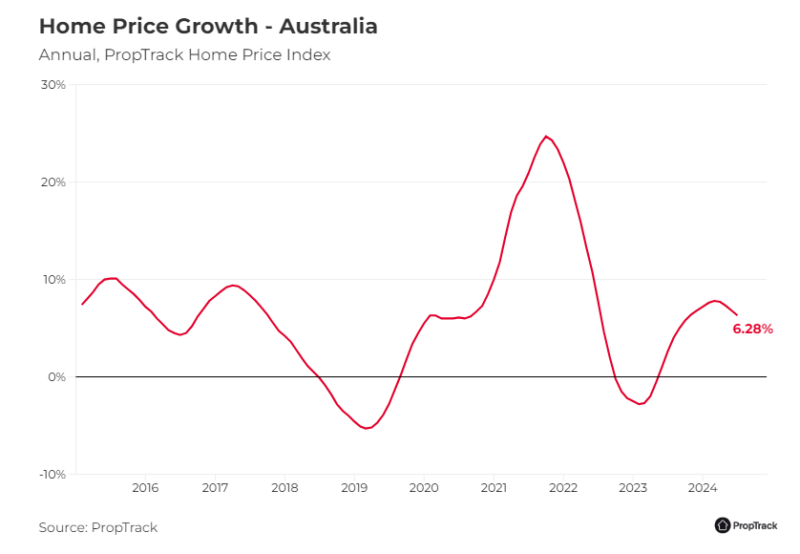
Key takeaways
National home prices increased 0.08% in July, to be 6.3% higher than a year ago. This slower pace of growth is to be expected in July, as it displays the slowest monthly growth on average.
Combined capital cities have increased 6.6% over the past year and continue to outpace regional markets, which recorded a first monthly price fall in July (-0.12%) since late 2022.
Perth (+0.88%), Adelaide (+0.58%) and Brisbane (+0.34%) continued to record the highest rates of price growth in July, with all of these capitals posting double-digit growth over the past year, with red-hot Perth hitting annual growth of 22.8%.
Melbourne prices recorded a fourth consecutive month of price falls, but prices are down just 1.5% over that period.
Sydney continued to record price growth, with prices up a further 0.12% in July, to be 6.1% higher over the past year and sit 4.8% higher than the peak recorded during the pandemic.
National home prices increased a further 0.08% across the country in July, according to PropTrack's Home Price Index.
This is a slower pace of growth than has been seen this year, which is not uncommon in winter.
Perth continues to outperform, increasing another 0.9% in July. National home prices continued to increase in July but only just, increasing 0.08%, the smallest monthly increase recorded since prices stopped falling in late 2022.
This increase pushed national home prices up 6.3% over the past year, to record a new price peak.
Mr Paul Ryan, PropTrack's Senior Economist commented:
"The slowdown in price growth is not unexpected, it coincides with continued strong listings activity and July is the seasonally weakest month for home price growth.
The July result means home price growth over the past three months has been below 1% for the first time since February 2023."
Capital cities continue to outperform, led by smaller capital cities
PropTrack's data highlights that combined capital city markets increased a further 0.15% in July to be 6.6% higher over the past year.
The smaller capital cities of Perth (+0.88%), Adelaide (+0.58%) and Brisbane (+0.34%) continued to lead price growth in July.
Mr Ryan further commented:
"Relative affordability and lifestyle factors continue to drive housing demand in these cities, with annual growth remaining above 10%, and Perth topping 20%.
By contrast, regional areas recorded a slight decline in prices in July, of -0.12%. This followed decreases in prices in many regional areas, most notably in regional Victoria where prices fell 0.63% in July.
Slower price growth in regional areas has been the norm after exceptional increases during the pandemic. Except in regional Queensland, South Australia and Western Australia, which all have posted double-digit price growth over the past year."
Outlook
The July data shows a continuation of trends that have played out over the past year.
PropTrack's data show that national prices continue to increase, but price growth has slowed.
In part this slowing is seasonal, but it also reflects binding affordability constraints as prices are more than twice the levels seen when interest rates were last at this level, in 2011.
Mr Ryan noted:
"All markets continue to see strong housing demand, tight rental markets and rebounding investor activity. However differences in relative affordability and home construction are driving divergence in outcomes across regions.
Perth, Adelaide and Brisbane continue to outperform. These markets have enjoyed relative affordability, but with Brisbane now the second most expensive market, price growth there may slow over the coming period.
By contrast, in Melbourne and the ACT, where prices are relatively high, and housing construction progressing more positively than elsewhere, there have been small declines in prices but broadly unchanged price levels over the past year.
The Sydney market sits somewhat between these two groups, with high prices but more constrained home construction. This continues to drive above-average price growth, up 6.1% over the past year.
Key to the outlook over the coming period will be continued strong income growth, which along with the Stage 3 tax cuts, has boosted disposable incomes and borrowing capacities.
As always, buyers and sellers will be focused on the course of interest rates. With the Reserve Bank set to meet in early August, some are tipping rates to rise further, which could quickly end the run of price growth the market has experienced since early 2023.
But on balance, we expect further modest rates of home price growth over the coming months as the market moves into the traditional spring selling season."















